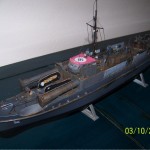Background: Craig Burke was a lifelong California State Park Ranger, an avid sportsman, and a good friend. He was the guy that you hoped you had as guide through the back country of a State Park. He attended UCLA and graduated in 1971 with a degree in Political Science. Soon after graduation, Craig became a California State Ranger, and was the model for the Mr. Ranger character in the Yogi Bear cartoon. Well, he could have been anyway. As a Ranger, Craig excelled in marksmanship and was invited to compete at The National Police Championships in 1981, where he won first place. He loved playing the guitar, and created a WW-II inspired board game entitled “Victory Through Seapower”. He also played golf and men’s volleyball. His love of travel led him and his wife Katie to visit all seven continents and a total of 56 countries.
The Award: The Craig T. Burke Memorial Hypothetical Modeling Award pays tribute to an icon of the San Diego IPMS modeling club. For over XX years, Craig produced hypothetical, kit-bashed models that were of superior modeling quality. However, the most endearing part of Craig’s models was not the just the finished product, it was the story telling that provided the background of how that particular ship, aircraft, or vehicle was designed, what mission the subject was meant to accomplish, and how effective the item was in combat. By weaving a convincing tale, Craig was able to convince his audience that the model represented an actual item. It would not be an exaggeration to call Craig’s work “Imaginodeling”.
Craig principally focused on 1/72 aircraft, but the club believes that any subject/scale will be allowed as an entry to increase participation.
Award Criteria:
- The model can be of any scale.
- The model can be of any subject (ship, aircraft, or vehicle).
- The model must meet all of the standard IPMS judging criteria for quality.
- The model needs to be of a 20th century theme.
- The finished subject must have been theoretically possible to build and operate.
- The modeler must provide a background story regarding how the actual subject would have been designed, and built.
- The story can be written, or presented orally to a set of judges. We would encourage the winner of the award to share his story with the audience during the awards ceremony – but only if the modeler wishes to do it.
- Judging points are awarded equally (50/50) between the model and the background story.
So get some popcorn, pull up a chair, and let’s see what an entry looks and sounds like….
A sample entry: October 1942 found the two Kretschmer brothers, Otto and Franz, back at the Wilhelmshaven shipyard in Germany as their respective boats were undergoing refit. The two brothers were Captains in the Kriegsmarine. Otto commanded a Type VII U-Boat and Franz commanded an E-Boat in the Baltic. Over dinner at their parent’s home, Otto told Franz that they were removing his 8,8cm deck gun as they nowadays almost exclusively engaged targets using torpedoes. The “Happy Times” were over as Allied Anti-Submarine Warfare technology had steadily increased. Franz told his brother that he wished he had a larger gun to engage the ever increasing numbers of Allied convoys going through the Baltic to Russia. The brothers decided that why should the U-Boat 8,8cm deck gun go to waste when a perfectly fine E-Boat might prove to be a worthy host. Provided of course they took off two torpedoes to account for the additional weight, and convince the Harbormaster to look the other way. Unlike their Allied PT Boat counterparts, field modifications of this scale were generally not permitted by Admiral Donitz, but then again, it was a request from the Kretschmers.
It took a little re-engineering and strengthening of the E-Boat, but when they were done, the one and only up-gunned E-Boat A1 was created.

